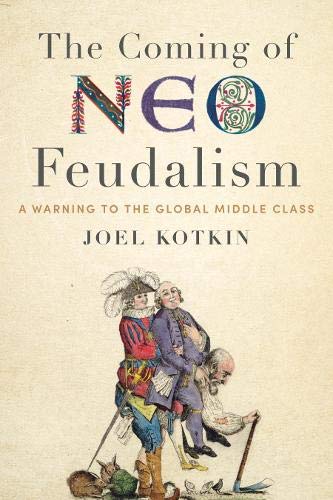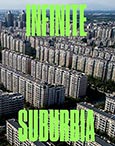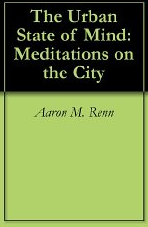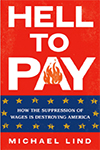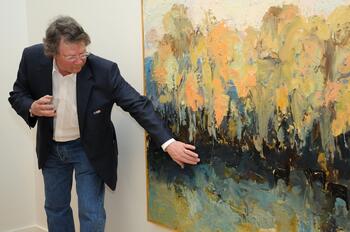
In an art world drunk on theory and spectacle, a Montana painter insists on snow, cattle, and weather—and on the discipline of seeing.
Most contemporary art has forgotten what a cow looks like. While the NEA funds performance artists smearing themselves with chocolate and major museums celebrate bananas duct-taped to walls, actual beauty goes unsubsidized. The art world has become a massive grift populated by many who mistake cleverness for wisdom and shock for significance.
I first saw Theodore Waddell's work at the Denver Art Museum nearly a decade ago, when Motherwell's Angus (1994) stopped me cold in a crowded gallery: six feet of Montana winter. From across the room, it read as a landscape with black cattle scattered across endless snow. Up close, it turned into paint; thick impasto ridged like frozen mud, marks more New York School than frontier postcard. For twenty minutes, maybe longer, the image toggled between abstraction and reality, between serious painting and the actual West.
At the time, it struck me as a remarkable painting. Today, it feels prophetic. In the midst of a culture war where elites peddle theory while working people navigate reality, Waddell's canvases carry urgent resonance. While MFA programs churn out theory-soaked graduates who can't draw but can certainly critique "systems of oppression," Waddell learned through calloused hands and frozen mornings about the realities he paints. Waddell’s canvasses remind us what we're losing, that some things remain stubbornly themselves. A cow is a cow. Snow is cold. Land stretches farther than ideology allows. As America's institutions drift into curated unreality and grievance performance, Waddell's work insists on the actual.
Paint with Weight
The black cattle in Motherwell's Angus aren't delicately drawn; they're dragged into being – dark incisions in a white field. The snow isn't white; it's lavender and blue sliding into gray, the color of cold that kills calves if you're careless. The tools are blunt - roofing brushes and masonry trowels that leave paint ridged like frozen mud. This is paint with consequences, paint that knows physics.
In winter canvases, the horizon drops out. Your eye keeps moving, as cattle move across frozen pasture; no destination, only persistence. These aren't animals as symbols or metaphors; they're 1,200-pound realities that need feeding when it's twenty below. Summer paintings reverse the energy: animals flicker like calligraphic marks against gold grounds, thin paint that reads as heat shimmer. Works such as Gallatin Angus and Gannett Angus reduce the animal to gesture without losing weight - abstraction that never forgets the actual.
Scale turns looking into weather. Stand before one of Waddell's twenty-foot canvases and you lose the privilege of distance. The painting surrounds you the way a blizzard does—peripheral vision fills with white, depth collapses, orientation falters. You're not observing a storm; you're in it. This is what ranchers know that museum-goers forget: weather isn't a view, it's an environment. It doesn't care about your theories or your timeline. At this scale, Waddell's paint becomes atmospheric pressure, his brushstrokes become wind. The gallery walls disappear. You're standing in Montana winter, where survival means reading the actual sky, not the weather app.
In Ruby Valley Angus (2009, 10×18 feet), held by the Booth Western Art Museum, animals blur into pattern, resolve into bodies, then blur again. You don't look at it so much as exist inside it; like actual weather, not climate abstractions peddled by activists on the far left. This is weather as ranchers know it: immediate, consequential, immune to politics.
Recent works let cattle recede into shadow while weather dominates. You can feel the barometer fall. These paintings know that nature isn't a progressive ally but an indifferent force that rewards competence and punishes wishful thinking. The sites -Monida, Lima, Beaverhead - aren't props; they're real places Waddell knows through work, not theory. Places where virtue-signaling won't keep you warm.
Against the Myth-Makers
Western art long carried the shadow of Charles Russell and Frederic Remington: the West as heroic stage, cowboys as actors. Even today, much "Western art" markets nostalgia to tourists: sunset silhouettes and noble horsemen, the West as conservative kitsch. Waddell rejects both this sentimentality and its opposite, the academy's hatred of beauty. He paints the West as workplace, where competence matters and reality doesn't care about your pronouns.
Compare him with many contemporary artists who seem to rely on their trust-funds to never hold real jobs, whose "practice" consists of writing grant applications and diversity statements. Waddell earned tenure at the University of Montana, then walked away in 1976 to ranch near Molt. He chose cattle over committees, seasons over semesters, and painted realities over fictions.
Our major institutions, meanwhile, celebrate destruction. At the 2017 Whitney Biennial, Jordan Wolfson's VR piece Real Violence forced viewers to watch a man beaten with a bat while Hebrew prayers played and all being subsidized by tax dollars. Critics praised its "urgency" and "confrontation with complicity." But it connected us only to nihilism, teaching nothing except that museums have abandoned their duty to preserve and transmit beauty. Waddell connects us to endurance, to the dignity of creatures surviving winter, to the sublime found not in theory but in temperature.
"I Can't Paint Anything I Can't See"
Waddell is blunt: "Montana has caused me to be who I am, and I love this place. I have to be where I am to paint what I paint." And more radically: "I can't paint anything I can't see."
In an age that treats truth as negotiable and expertise as oppression, that ethic of direct observation feels almost revolutionary. While academics insist reality is "socially constructed" and biology is a "spectrum," Waddell paints only what he knows through experience, not ideology. His statement - "I can't paint anything I can't see"- stands as a rebuke to every artist statement filled with jargon about "interrogating liminal spaces" or "disrupting heteronormative paradigms."
Out at the ranch and in the prairie, "you can see for 150 miles in any direction.” No mediation, no curation, just land and sky. Sculpture, his earlier mode, made no sense at that scale; he returned to painting cows. Not as symbols of environmental destruction or capitalist exploitation, but as cows. Imagine that.
He painted at 3:30 a.m. before chores; during calving season, at 2 a.m. after checking the herd. This is how actual knowledge is earned—through repetition, observation, and exhaustion, not through graduate seminars on "decolonizing the visual field." In 1987, a blizzard hit after calving. Waddell pulled dead calves from drifts as mothers stood over them, then painted for sixteen hours; not death as concept, but death as fact, persistence as necessity. "The understanding of death," he wrote, "brings about a feeling of wonderfulness and appreciation of life." No trigger warnings needed, no content advisories required. Just truth.
Evolution Through Constancy
Waddell stepped away from ranching in the 1990s, but the knowledge stayed in the paint. Early works were thick, almost sculptural - paint as material fact. Later, he layered oil with wax, letting marks show through, history built into surface. The paintings grew atmospheric, but never decorative, never mere aesthetic experience divorced from labor. Unlike government-subsidized "art" that requires wall text to explain why it matters, Waddell's work actually sells; beauty finds buyers, ideology needs bureaucrats.
This constancy, cattle and weather for half a century, resists both market novelty and academic fashion. While younger artists frantically rebrand themselves with each news cycle, mining Twitter for the next thing to be upset about, Waddell keeps painting the same subjects. Not from poverty of imagination but from its opposite: the knowledge that reality is inexhaustible, that each season reveals something new to those who actually look rather than theorize.
Recognition has come mostly west of the Rockies, in places where people still work with their hands: exhibitions at Denver and Eiteljorg, a 2015 Montana Governor's Arts Award. The coastal elites barely notice, for they are too busy celebrating "interventions" and "disruptions" to recognize actual achievement. Their loss, our clarity. While they chase the next trend, Waddell compounds wisdom like interest, each painting building on forty years of looking.
The Ethics of Looking
Stand before a Waddell painting long enough and something shifts. The clever ironies you brought with you - the ones that get you through museum galleries full of approved provocations - fall away. You're left with something harder: the demand to actually see. Not interpret, not decode, not "interrogate." Just see.
This is what Motherwell meant by ethical consciousness in painting; not virtue signaling on canvas but the discipline of sustained attention to what is. Motherwell believed that every mark carries moral weight, that abstraction itself could be an act of truth-telling. Waddell understood this. His cattle aren't just subjects; they're ethical commitments to seeing what's actually there. As such, Waddell doesn't paint his politics or his feelings about cattle. He paints cattle, in specific light, in particular weather. The ethics emerge from that restraint, that refusal to make the world carry his meanings.
Try explaining this at a meeting like Davos, where oligarchs with homes on three continents preach sustainability between private jet flights. They'd call Waddell's commitment to one place "narrow." But fifty years in Montana has taught him what they'll never learn from their conference panels: wisdom comes from limitation. You see past surfaces only by staying put, by watching the same field through sixty seasons until you understand that abstraction without encounter is just sophisticated lying. Simone Weil knew this: rootedness as the soul's deepest need, the one our credentialed classes can't even recognize anymore.
Watch people at galleries now, the quick phone snap, the audio guide summary, the performative appreciation. Waddell's paintings refuse this consumption. They demand what Roger Scruton called the education of the gaze: stand close enough to see paint ridged like dried mud, step back until cattle emerge from marks, wait through your boredom until the painting starts working on you instead of you working on it. In our culture of hot takes and viral moments, this is almost an act of rebellion; art that won't be reduced to content, that insists on being encountered rather than consumed.
Culture, Somewhere
Waddell's paintings rebuke placelessness. As David Goodhart argues, society splits between mobile "Anywheres" who mistake credentials for competence and rooted "Somewheres" who know what things actually cost. Waddell is firmly Somewhere. His canvases insist that place matters, that the universal flows from the particular, not from sociology departments or DEI workshops.
Here his work converges with Wendell Berry: modern life unsettles us from land and consequence. Global elites who lecture about "sustainability" from private jets have never sustained anything real, not a ranch, not a herd, not a community, not a marriage. Waddell has. For fifty years. Through Republican and Democrat administrations, through cattle prices rising and falling, through art world fashions that would make his work "problematic" (too white, too male, too focused on extraction industries), he kept painting what he saw.
This persistence itself becomes political. In an age of fluid everything - gender, borders, currency- Waddell's commitment to depicting actual cattle in actual weather reads as resistance. Not conscious resistance, nothing so programmatic, but the deeper resistance of someone who knows what he knows and won't pretend otherwise.
The Urgency of Now
That is why Waddell matters now. We live drowning in abstractions—digital, ideological, bureaucratic. We're told reality is constructed, merit is privilege, biology is optional, and math is racist. Universities that once taught Newton now teach nonsense. Museums that once preserved beauty now platform narcissism. Waddell's canvases refuse all of it. They remind us: snow is cold, cattle are heavy, winter kills if you're careless. No committee can vote otherwise. No theory makes it untrue.
The culture war will not be won in faculty lounges or on Twitter. It will be won in the recovery of sight; the ability to see what is there and to name it without apology. Every Waddell painting is a small victory against the long march through the institutions. They are proof that truth, beauty, and the American spirit survive wherever someone still chooses earned knowledge over credentialed ignorance, wherever someone values what works over what sounds smart at parties.
Look at his paintings. Look hard. Stand close enough to see the paint ridged like frozen mud. Step back to see cattle emerge from marks. Give them time - the time we no longer give anything, the time that reveals rather than consumes. The museums may be captured, the galleries corrupt, the NEA a welfare program for regime propagandists, but reality remains undefeated.
In an age drunk on abstraction and spectacle, what could be more radical than insisting that a cow is a cow, that Montana is Montana, and that both are enough? What could be more necessary than someone who refuses to paint anything he cannot see?
Samuel J. Abrams is a professor of politics at Sarah Lawrence College, a senior fellow at the American Enterprise Institute, and a scholar with the Sutherland Institute.
Photo: Theodore Waddell with "Wood River Angus" via Flickr under CC 2.0 License.








